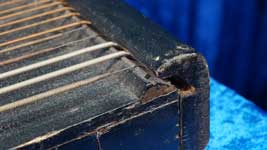
Surmandal otherwise known as swarmandal, is basically a small harp. It is generally used for the drone to accompany vocalists. Although it is considered a minor instrument, as a class the harps are very old in India.
| THESE BOOKS MAY NOT BE FOR YOU |
|---|
A superficial exposure to music is acceptable to most people; but there is an elite for whom this is not enough. If you have attained certain social and intellectual level, Elementary North Indian Vocal (Vol 1-2) may be for you. This has compositions, theory, history, and other topics. All exercises and compositions have audio material which may be streamed over the internet for free. It is available in a variety of formats to accommodate every budget. Are you really ready to step up to the next level? Check your local Amazon. |
Tuning the Surmandal
There is no such thing as a standard tuning for surmandal. Although this lack of standard tuning is discomforting to the average Western musician, it really is rather obvious. We must not forget that:
- There is no standard size for a surmandal.
- There is no standard number of strings.
- Different individuals will sing from different keys.
- One tunes the surmandal to the rag, every one of which will be different.
One should not be confused by this. As with many other Indian instruments, there may not be any standard tuning, but there are only a few standard approaches to tuning.
Stringing a surmandal for any individual is basically one of trial and error. Fortunately the latitude is so great that there is very little “error”. It is usually more a question of individual taste. Simply start the low strings with strings that are that are intuitively low (e.g., brass, bronze, wire wrapped, etc). Start stringing it, and then gradually work your way up to strings which are intuitively high (e.g., light gauge, steel).
Tuning is very simple, but you must first know two things. You must know what key that you sing in (i.e., safed ek (C), kali ek (C#), safed do (D), etc.). You must also know what rag that you wish to perform. We must presume that you know both of these things.
Start the tuning with the lowest string and work your way up. Simply start with the lowest string and tighten it until the tension feels comfortable. At that point find the nearest note which is in the rag and tune to it. Try to tune to Sa or Pa. Then tune the next string, and the next, etc.
You will quickly reach a point that the strings are getting too tight. At that point you can double up on the tuning. That is to say that you tune two or more strings to the same note. Then again you go up the scale. Again you reach a point where it is getting too tight. Again you double up the tuning. Repeat this entire process until the instrument is in tune. One can use any note to double up on, however Sa and Pa are very comfortable.
Initially it is good to tune to a seven note scale (sampurna jati) (see jati for more information). Therefore, if you need to switch to a five note scale (audav) or a six note scale (shadav), then all that you have to do is double up on the appropriate strings. You do not wish to go back and retune the whole instrument when simply doubling up on the strings will do the job.
The surmandal is now in tune.
There is another approach to tuning which works very well. Initially tune the surmandal to a chromatic scale. Start at wherever is convenient for the instrument and end wherever is convenient. This will be the base from which you work. Next, visualise your own particular key. Then go and detune (either up or down) to every pitch that does not conform to a diatonic tuning for your key. This will tend to produce a tuning that gives one string each for your tonic. (i.e. One string each for Sa and Pa per octave) and multiple strings for the others (i.e. Re, Ga, Ma, Dha, Ni). This particular approach is very convenient for the performing musician, because when one is on stage, it will on balance, require only a modest number of strings to retune as one shifts from rag, to rag, and it will not be thrown off by the many rags which use both forms of the notes (i.e., both Nis in Khammaj, both Mas in Bihag, etc.)
As you work with your surmandal you will find yourself tailoring it to your own needs. You will find that changing the gauge or material of a string here and there, or a slight alteration of the tunings are in order. However, you will find that very quickly you have your surmandal as you like it.
Photo Gallery
Click on image

Surmandal

Sound hole

tuning pegs

String attachments